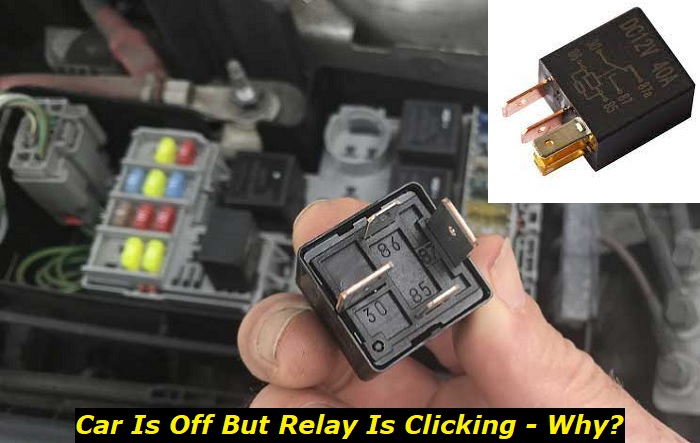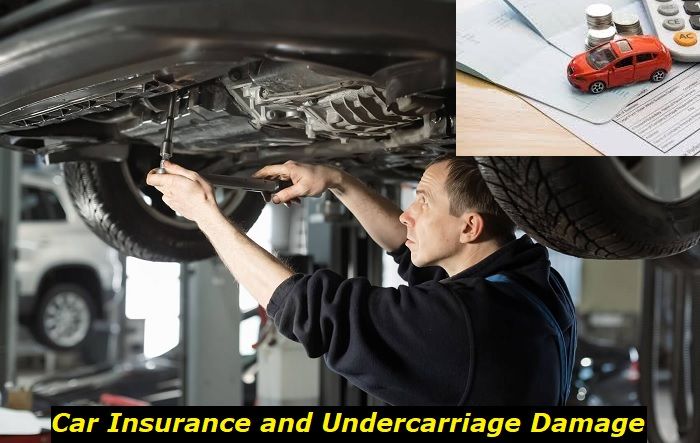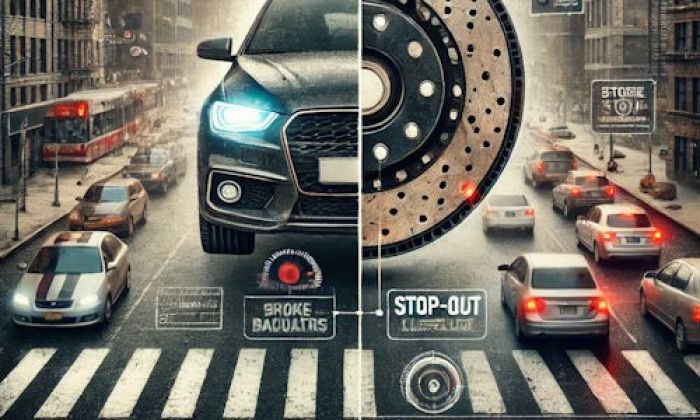A relay clicking when the car is off is a sign that a relay is going bad. Relays are electromechanical switches that can open and close a high-current circuit using a low-current signal. The action of a relay opening and closing can produce an audible clicking noise. If a relay gets stuck or goes bad, it might not be able to close this circuit, resulting in a repeated clicking noise.
Relay problems highlights
- Level of urgency:low
- DIY inspection:possible but complicated
- DIY repair:possible
- Can you drive?yes
- Price for repairs:$20 - $250
- Symptoms:certain functions may not work, clicking sound
- Ways to solve:replace the faulty relay

Why is a Relay Clicking?
If you hear a clicking sound from a relay shortly after turning off your car, then you have a faulty relay. You might hear the sound of the relay clicking from the hood or the dashboard. This is because relays are located in the dashboard and the engine compartment.
Before we can understand why a relay is clicking, it's important to know how they work.
How Does a Relay Work?
Relays use an internal electromagnet to open and close a circuit to control the flow of electricity. They extend the lifespan of a switch by passing high-current electricity through the system without it going through the switch. This prevents the switch from burning out.
A relay receives a low current signal which activates the electromagnet inside. This causes the electromagnet to close the secondary circuit. A high current runs through the secondary circuit and powers the attached component.
Relays are used as switches by components that require a lot of electrical energy to operate. Examples of these components are the headlights, windshield wipers, and air conditioning.
When a relay goes bad, it won't be able to close the secondary circuit. This results in a clicking noise as the relay repeatedly attempts to close the circuit.
If the relay is clicking shortly after the car is turned off, this is a sign that the relay is stuck in the closed position. The relay is attempting to break the circuit when the car powers down, but the mechanism is stuck. This results in a repeated clicking sound as the relay continues to attempt to break the circuit.
A relay that is stuck in the closed position can result in battery drain. This is because the secondary circuit can't be closed, so it remains live, which drains power from the battery.
Why Does a Car Relay Fail?
A relay can go bad for several reasons. Here are some of the main reasons why car relays fail.
- Mechanical wear
- Contamination of the moving parts
- Corroded or worn contacts
- Electrical overloading
- Overheating
- Short-circuits
How to Fix a Relay Clicking?
A faulty relay needs to be fixed as soon as possible. This is because they can result in other complications and issues in the car.
Examples of the problems that a bad relay can cause are:
- The battery loses charge even after the car is turned off.
- Certain electronic systems work intermittently or don't work at all.
- Certain electronic systems might not turn off even when the engine is off.
When a relay goes bad, the only option is to have it replaced. Keep reading to find out how to replace your car's faulty relay.
How to Change a Bad Relay
A bad relay will need to be replaced. While you always have the option of getting it replaced by a mechanic, the process is simple enough to be done even with minimal repair experience. All you will need is to order a replacement relay and follow the instructions below.
When ordering a replacement relay, make sure to order one that is an exact match for your former relay. You can check the part number on the faulty relay and order a replacement with the same part number online. This helps to prevent premature failure of the relay.
If you're ready to fix the relay clicking problem in your car, then let's take a look at the process of replacing the faulty relay.
1) Locate the Faulty Relay
The first step to replacing a faulty relay is to find it. Relays are housed in a fuse box that contains the relays and fuses your car needs. Most cars come equipped with two fuse boxes. One fuse box is located in the engine compartment and contains relays and fuses for engine components like the Engine Control Module and cooling fan. The other fuse box is located in the dashboard and controls the interior electronics.
If the sound is coming from behind the dashboard, then the bad relay is located in the dashboard fuse box. The position of the dashboard fuse box varies depending on the make of your car, but it is usually located on the driver's side of the control panel, between the door and the dashboard. It might also be located in the footwell.
On the other hand, a clicking sound coming from under the hood indicates that the bad relay is in the engine compartment fuse box. This fuse box is easier to find and is usually toward the front of the engine bay on the passenger's side.
If you're having trouble finding the fuse box, check the manual for your car to find out exactly where the fuse box is, and how to open it.
2) Identify the Faulty Relay
Often the only sign a faulty relay will give is the clicking noise it makes. There might be no signs of visual damage.
One way to identify a bad relay is to have someone else start the engine and then turn it off for you. Once the relay starts clicking, feel the fuses with your hand. A clicking produces a vibration that can be felt with your hand.
Check the part number and get a relay that is an exact match. This is important because using the wrong type of relay could result in electrical damage to the car.
3) Remove the Faulty Relay
You should be able to do this with your bare hands, though some cars might require a tool. To remove the relay, simply grab hold of it and pull it out of the fuse box.
4) Install Your Replacement Relay
In most cars, you should be able to do this by simply pushing it into position.
How to Tell if the Fuse Box is Failing
While a clicking relay is usually the result of a worn or jammed mechanism, faulty relays can sometimes be caused by a failing fuse box. A failing fuse box is a serious issue that can lead to extensive problems with a car.
Fuse boxes are typically built to last a long time, but they can fail in some situations. There are some signs that a fuse box will give when it is starting to fail.
Here are the symptoms that indicate you have a failing fuse box.
- Fuses and Relays Fail Frequently
The main symptom of a problematic fuse box is when the fuses go bad frequently. If the fuses blow often, or the relays fail often, then you might have a wiring problem in the fuse box.
If the same fuse or relay continues to blow, even after being replaced, then the fuse box might have a short circuit. You will need to have the fuse box inspected by an automotive electrician to confirm this.
- Fuses Fall Out or Shake Loose
If the fuse box is damaged physically in any way, then the fuses and relays might not sit firmly in their sockets. In a healthy fuse box, the fuses should sit firm and require some effort to remove. If the fuses and relays can be shaken in their socket or removed with minimal effort, then your fuse box is probably damaged.
This is resolved by replacing the fuse box.
- Burned Terminals
If you open your fuse box and notice burned relays, fuses, or terminals, this is a sign of a more serious issue with your fuse box.
This is a sign of short circuits, electrical overload, or overheating. The fuse box will most likely need to be replaced and rewired.
Conclusion
A relay that clicks when the car is off has gone bad. Relays control many systems in your car, so a faulty relay can have unpredictable effects. The best way to deal with a bad relay is to replace it promptly.
The faulty relay will be located on the driver's side of the dashboard or the engine compartment. You can identify the faulty relay by feeling for the clicking with your hand. Once you've identified the bad relay, make sure to replace it with an identical replacement.
About the authors
The CarAraC research team is composed of seasoned auto mechanics and automotive industry professionals, including individuals with advanced degrees and certifications in their field. Our team members boast prestigious credentials, reflecting their extensive knowledge and skills. These qualifications include: IMI: Institute of the Motor Industry, ASE-Certified Master Automobile Technicians; Coventry University, Graduate of MA in Automotive Journalism; Politecnico di Torino, Italy, MS Automotive Engineering; Ss. Cyril and Methodius University in Skopje, Mechanical University in Skopje; TOC Automotive College; DHA Suffa University, Department of Mechanical Engineering






Add comment